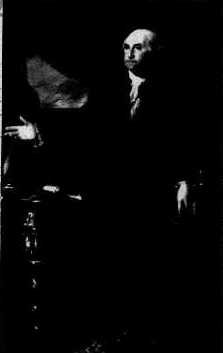
THE WHITE HOUSE AND ITS SETTING

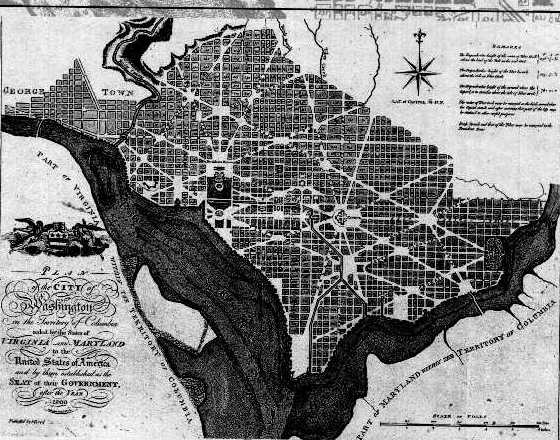
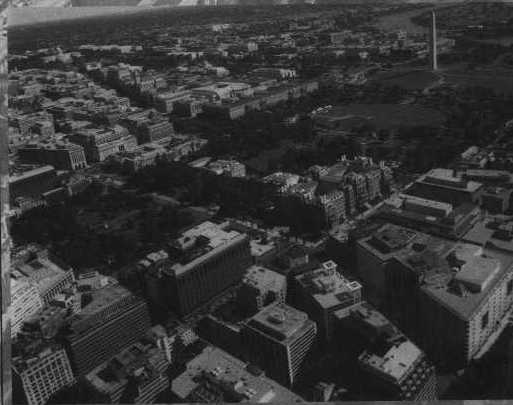
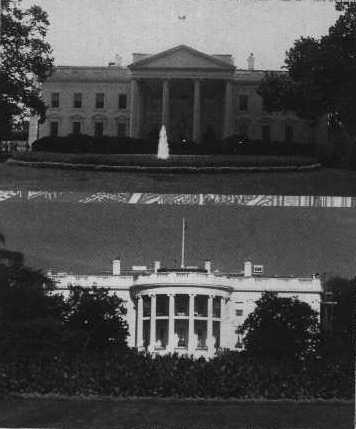
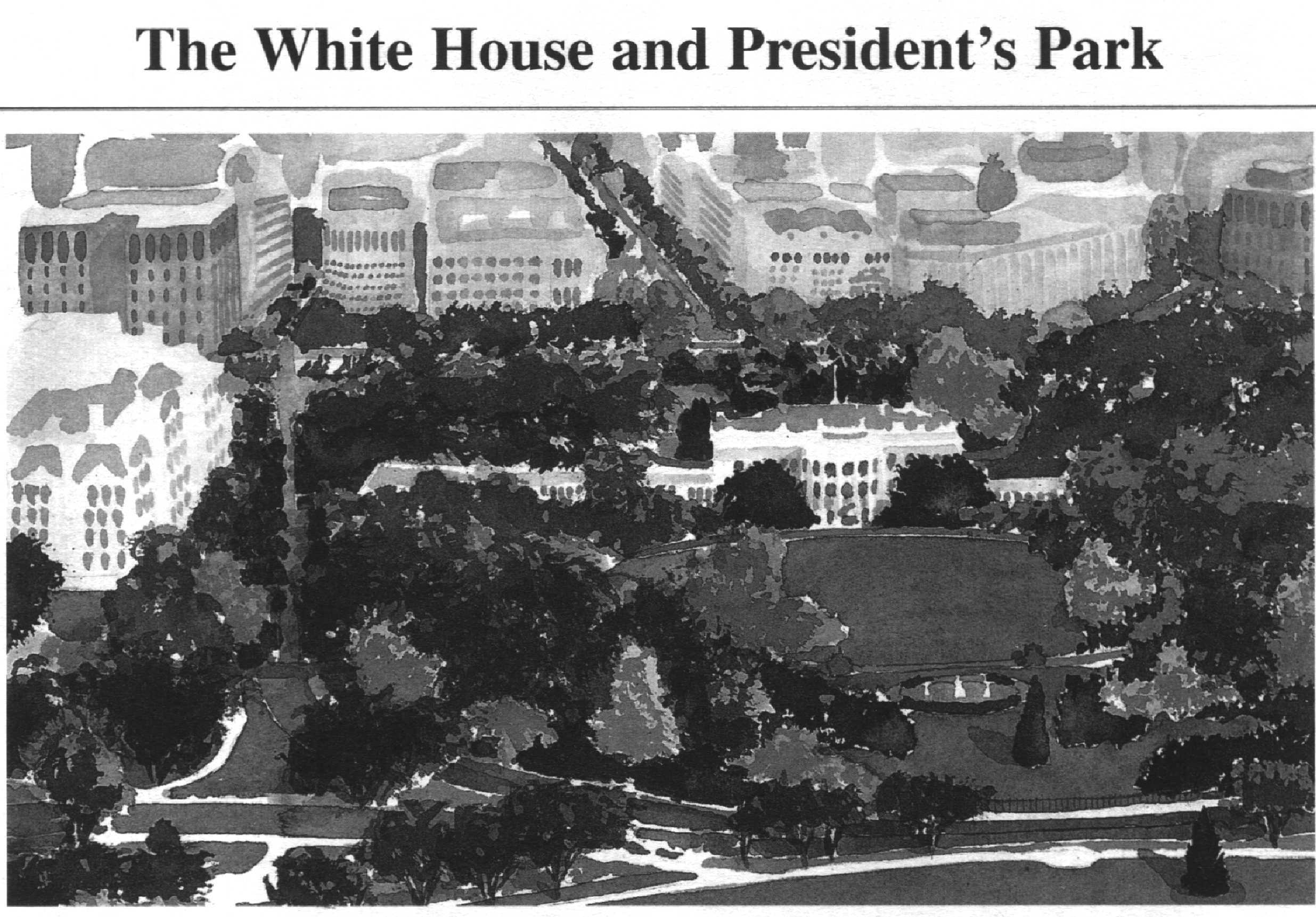
PURPOSE OF AND NEED FOR THE PLAN
INTRODUCTION 7
The White House and President's Park-7
Purpose of the Plan 9
Need for the Plan 9
The Planning Process-9
THE CONTEXT FOR THE PLAN 1 2
The Purpose of the White House and
President's Park 12
Significance of the White House and
President's Park-13
Design Guidelines-14
Desired Futures-16
Primary Interpretive Themes 19
PROBLEMS, ISSUES, AND CONCERNS
CONSIDERED IN THIS DOCUMENT 20
Resource Conservation and Management 22
Home and Office of the President 24
Visitor Use and Services 26
Special Events 29
Transportation-29
Site Management and Operations 31
Concerns and Issues Eliminated from Consideration-32
RELATIONSHIP OF THIS DOCUMENT TO
OTHER PLANS AND EFFORTS 33
Washington, D.C., Plans 33
NPS Plans and Initiatives 40
Other Federal Plans 42
" [ History ] clearly shows that we arrive at catastrophe by failing to meet situations - by failing to act where we should act. . . [ The] opportunity passes and the next situation byways is more difficult than the last one.
-Eleanor Roosevelt--
The White House and President's Park
* It is the home and office of the president of the United States and the settings for official presidential functions including, dinners and welcoming ceremonies for foreign heads of state.
* It is the center of the executive branch of government. the headquarters of the commander in claim of the nation's armed forces. and an office complex.
* It is a unit of the national park system, a public tour destination, and a fully accredited museum.
* It is the place where citizens have the constitutional right to come and petition the president.
* It is a focus for popular public celebrations such as presidential inaugural parades. annual Easter edit rolls. and the Pageant of Peace in December.
The White House and President's Park, including Lafayette Park, and the Ellipse are a public trust. important symbols of our nation's heritage. The management of this area must remain flexible to accommodate the various
Vicinity
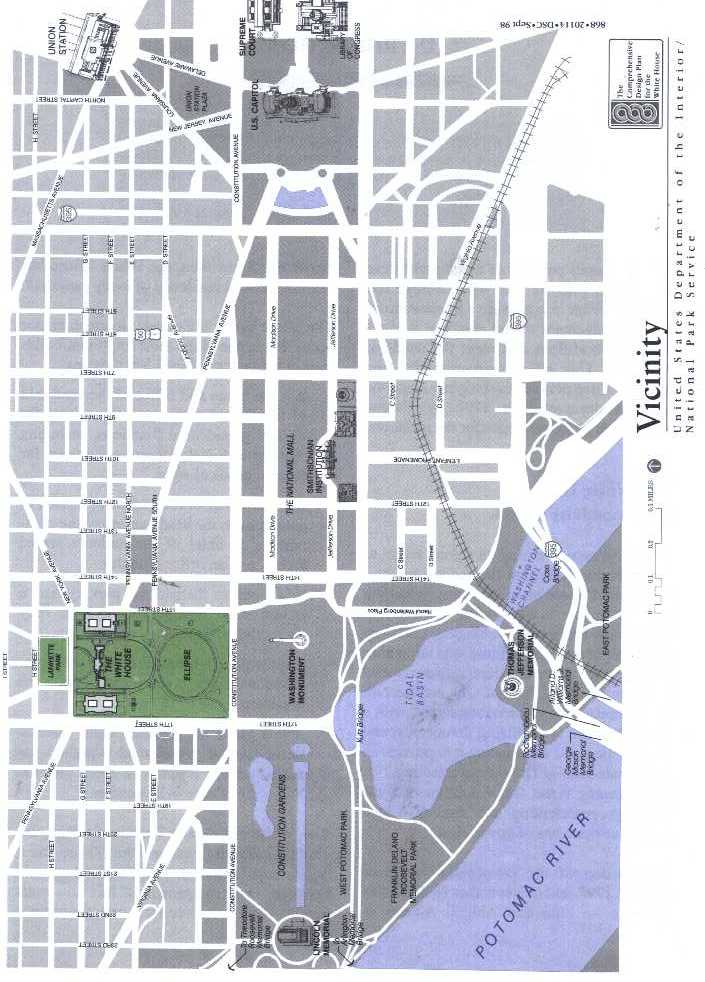
formal and informal uses that occur daily. The preservation of the site's resources must be ensured by prudent and adequate planning and by sensitive design. These are the planning and design challenges inherent at the White House and President's Park.
Purpose of the Plan
1. Identify what needs and functions will have to he
accommodated at the site over the next 20 years
2. Determine how best to ensure the provision of important
resources on the site, including the White House itself.
3. Solve the logistical and management problems that have
developed over the years.
Need for the Plan
The Planning Process
Purpose and Need for the Plan
Congress provided funding to the National Park Service to begin the planning process in 1992.
Site Jurisdiction
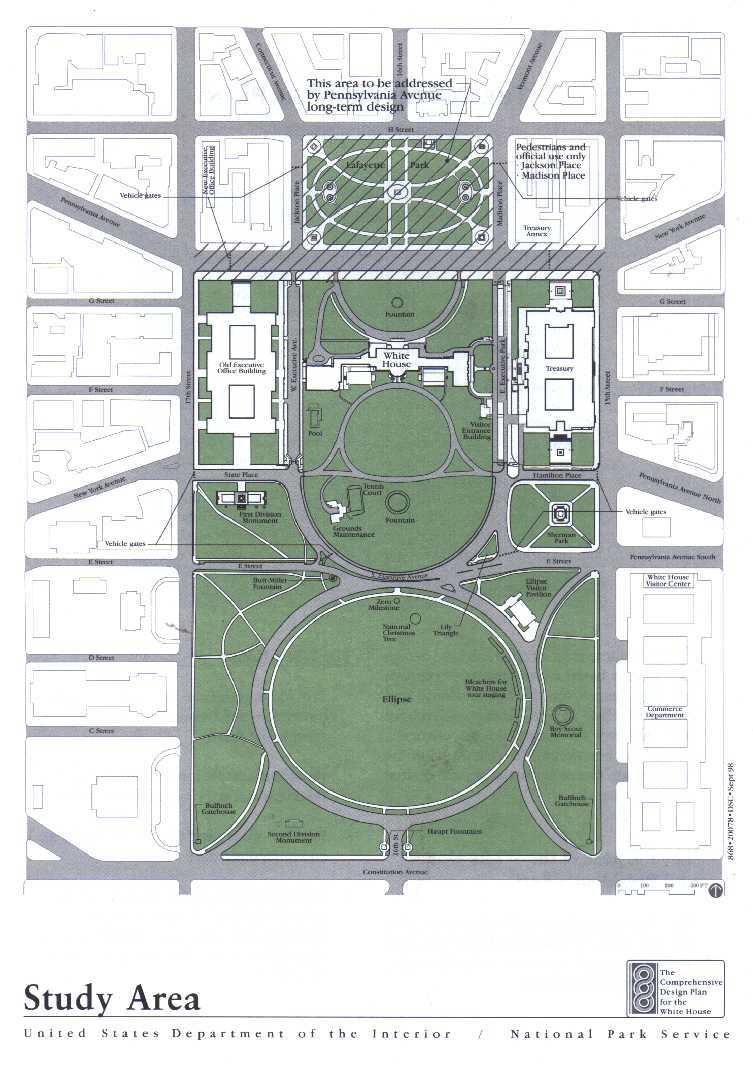
The White House, more than any other public structure in the United States, exemplifies the history of the presidency of the United States of America. Every president has been associated with this building --- George Washington selected the site and oversaw initial construction, while all succeeding presidents have lived within its walls. The White House and the surrounding President's Park are enduring symbols of our republican form of government and the democratic principles on which it was founded.
The vision for the future management of the White House and President's Park is to continue to celebrate the rich traditions of the past while adopting technological advances to meet the needs of the future. Through comprehensive planning, the White House will continue to serve the president and the executive branch of government. Public access to the White House, which is symbolic of access to the government of our country, will remain available to all citizens. As a unit of the national park system, President's Park will continue to set preeminent standards for resource protection and design excellence, and its management and use will exemplify the highest ideals of interagency cooperation and public service.
The Purpose of the White House and President's Park
The White House
* Provide a residence that offers privacy, protection, and recreational opportunities for the first family.
* Provide a suitable location for the official functions and activities of the presidency.
Provide office facilities for the president and immediate staff.
* Preserve and interpret the museum character of the White House; provide public access to the principal corridor on the ground floor and to the state rooms on the first floor.
The Context for tile Plan President's Park
* Preserve the cultural resources of the White House its architecture, artifacts, landscape design, gardens and grounds, and the surrounding parklands in ways that foster and preserve dignity and respect for the office of the presidency, while still allowing for their use.
* Provide a dignified transition area from an urban environment to the White House environs.
* Interpret the history and significance of the presidency, the White House, and President's Park, including their relation-ship to the American public, our republican form of government, and the growth of Washington, D.C.
* Preserve existing historic memorials as examples of memorial art.
* Provide a large open area associated with the White House for freedom of public expression and assembly activities, as well as for public use and enjoyment.
* Protect and enhance views to and from the White House and provide a setting for viewing the White House.
* Preserve Lafayette Park as open public space in the foreground of the White House, as a setting for passive activities (reflecting, observing, making a personal connection with the presidency), First Amendment activities within legal limitations, and as a support area for presidential inaugural activities.
* Preserve and interpret Lafayette Park as one element of the oldest planned federal reservation in the nation, an example of early American landscape design, and the 19th century neighborhood of the president.
* Provide a setting for viewing the White House and elements of the Lafayette Square National
Historic Landmark District.
Significance of the White House and President's Park
The White House
PURPOSE OF AND NEED FOR THE PLAN
and the focus of diplomatic relations with other countries. As such, the White House is the setting for interactions between the public and the president, as well as between the president and other heads of state. To many the White House is a symbol of a free and democratic nation because it is accessible and open, as is the ideal of the democratic process. Its endurance for 200 years reflects the stability of our nation. As a result, the White House evokes an extraordinary range and depth of emotions among U.S. citizens and visitors from other cultures and countries.
President's Park
Design Guidelines
The Context for the Plan
1.Site elements from earlier significant planning efforts will be respected and conserved, including the classical 18th century forms that are inherent to the layout of President's Park and the city of Washington, D.C. All components of President's Park are designed historic landscapes, and the Secretary of the Interior's standards for Historic Preservation will be followed in the management and treatment of these landscapes. 2. The distinct character of each of the site's three areas Lafayette Park, the White House and the Ellipse - will be respected, white recognizing that together these areas function as a significant - design element in the layout of Washington, D.C. 3. The design vocabulary and palette for the site will complement and articulate the dignity and importance of the resource, drawing from the existing appropriate architecture and landscape architecture in and around the site. To this end, proposed elements will respect the size, scale, mass, proportion, and the spatial relationships between them. 4. The traditional vistas from the White House to the north and south, as well as vistas toward the White House, will be respected of all times. 5. All designs will incorporate sound environmental, principles and environmentally and economically beneficial resource management technologies and practices. 6. The quality of the pedestrian experience will remain a high priority in all designs. 7. The needs to accommodate service security, and ceremonial functions will be met in a manner that is consistent with the dignity and importance of the site. 8. Neither security nor aesthetics will be compromised by actions on site. 9. Design elements that communicate appropriate visual quality, continuity and consistency will define the boundaries of President's Park and will create a specific identity for the park, but will also complement the design qualities of adjacent areas. * Materials used on the she will be compatible will its unique character. To this end all items used in the park --- benches, stonework grillwork, fences, light posts, and other elements --- will relate to the whole and will relate to the whole and will complement the overall District of Columbia federal park system.
* All elements must be designed to withstand intense use while still importing a sense of dignity and elegance.
* Transitions into President's Park should show a connection with the city. The quality and appearance of materials will announce a special precinct, President's Park and the National Mall need special treatment as transition zones that reinforce mutual relationships.
* Signs and signals will be kept to a minimum within and adjacent to President's Park, consistent with adequate visitor orientation and safety messages.
10. Plant materials will reflect traditional landscape elements in mass and alignment. The choice of specific planning materials will remain flexible but will be guided by the intent of principle I and will complement the palette of existing plant materials. * The landscape design will continue to use vegetation to define and refine spatial relationships.
* Planting and planting designs outside the White House fence will complement those inside the fence in qualify, scale, and selection.
11. Designs for President's Park will remain flexible and capable of being appropriately adopted in response to technological advances, future demands, and changes in adjacent historic and commercial neighborhoods.
PURPOSE OF AND NEED FOR THE PLAN
Desired Futures
Resource Conservation and Management
The Context for the Plan
Home and Office of the President
Internal Functions:
Space Requirements - Secure space is provided for first family indoor recreational activities. Space is available in or near the White House to store materials and stage meetings and official functions. News media facilities are provided and can be easily upgraded for state-of-the-art communications. Deliveries - Supplies and materials are delivered efficiently and discreetly to the White House. Access - Access to the White House for presidential and official visitors remains flexible. All visitors are screened quickly and efficiently and welcomed in a cordial way, befitting a visit to the home and office of the president. Infrastructure - Utility and communication systems are upgraded to be efficient, environmentally and visually sensitive, and easily maintained. Temporary systems respect significant site resources and meet the needs of White House events.
Visitor Else and Services
Information / Orientation:
Interpretation / Education:
White House - Visitors are educated' in-spired, and empowered by the White House its rooms, character, many uses, past and present occupants, history, and symbolism through a variety of interpretive tools' including personal services, programs, and exhibits. Visitors are introduced to the ideals of democracy and understand why it is important to become involved in their country's future.
PURPOSE OF AND NEED FOR THE PLAN
President's Park Resources - Visitors are educated about other resources of the White House and President's Park, such as natural resources, historic structures, landscapes' monuments, and archeological resources, to increase their personal involvement with the site and thereby con-tribute to its preservation.
Public Outreach - A plan for public out-reach is regularly updated and is used to contact the broadest possible audience.
White House Tours:
Visitor Services:
Basic Services - Safe, comfortable shelter is available during inclement weather, and basic visitor services are provided on the site or are easily accessible. Ticketing - Opportunities for day-of-visit reservations continue to be available for White House tours.
Special Events
Transportation
Site Circulation:
Pedestrian Environment - People are able to walk safely throughout the site, without conflicts with moving or parked vehicles. Pedestrian Circulation - People travel easily around the site by means of a convenient, easily accessible transportation system (such as a shuttled that connects with other facilities and visitor opportunities.
The Context for the Plan
Primary Interpretive Themes
* The White House is a symbol of the presidency, of a free democratic society and through its continuity, of the stability of our nation.
* President's Park, as a primary element of the federal city, serves as a stage for active participation in the democratic process, and is linked by Pennsylvania Avenue America's main street to the legislative and judicial processes on Capitol Hill.
* The White House is a mirror and magnifier of the nation's cultural, recreational, and topical history.
* The White House is the seat of the executive branch of government.
* Many people from different backgrounds and cultures have been essential in the growth and operation of the White House as the home and office of the president.
* The White House is an example of the continuum of history through its stories as well as its artifacts.
* The stability of the design and architecture of the White House and President's Park is a product of continuing adaptation to changing needs and technology.
* The responses of presidents and first ladies to the challenges of the presidency provide important lessons in their varying capabilities to handle difficulties.
PROBLEMS, ISSUES, AND CONCERNS
CONSIDERED IN THIS DOCUMENT
* Resource Conservation and Management problems and concerns relating to the cultural landscape and the protection of cultural and natural resources
* Home and Office of the President - concerns relating to the Executive Residence (the White House proper, see the figure on page 26) and office support functions
* Visitor Use and Services concerns relating to the interpretation of the site to visitors and public educational opportunities, White House tours, and recreational opportunities
* Special Events-concerns related to the management of public events, inaugural parades, and large demonstrations and marches
* Transportation-problems and concerns relating to visitor access, staff parking, site circulation' traffic congestion, and pedestrian safety
* Site Management and Operations- concerns relating to utilities, infrastructure, and daily operations